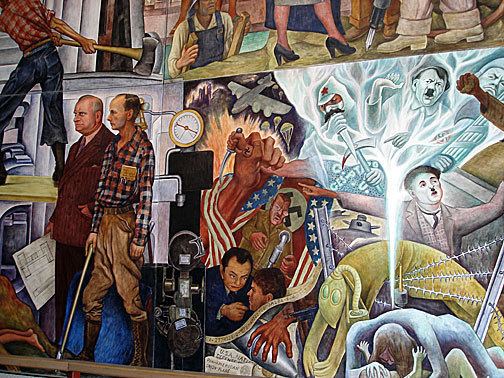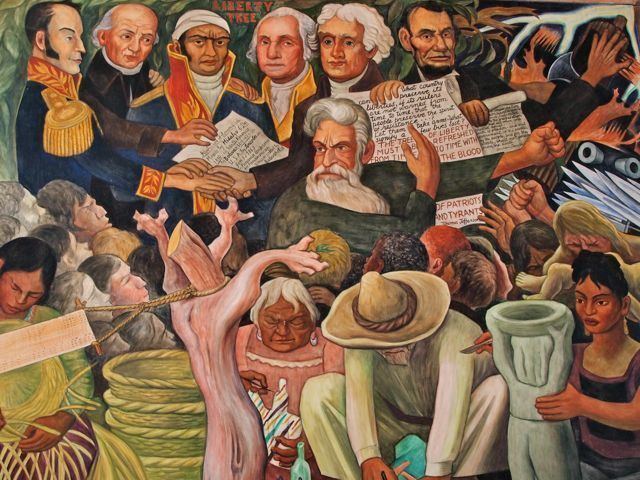Created 1940 | ||
 | ||
Similar Man at the Crossroads, Zapata (lithograph), The History of Mexico (mural) | ||
Mexican muralist Diego Rivera painted Pan American Unity for the Art in Action exhibition at Treasure Island’s Golden Gate International Exposition (GGIE) in San Francisco, California in 1940. This work was the centerpiece of the Art In Action exhibit, that featured many different artists engaged in creating works during the Exposition while the public watched.
Contents

History

The formal title of the piece, as given by Rivera is Unión de la Expresión Artistica del Norte y Sur de este Continente (The Marriage of the Artistic Expression of the North and of the South on this Continent) , but is more commonly referred to as Pan American Unity. This true fresco was painted locally in San Francisco and was donated as a gift for City College of San Francisco after GGIE. At the time of the mural commission, San Francisco Junior College's leadership had planned on installing it at the yet-to-be-built Pfleuger Library after the closing of the 1939 - 1940 World's Fair. With the start of the Second World War, the construction was postponed indefinitely and the mural was placed into storage at the college.

In 1961, when the CCSF campus theater was built, the younger brother of the library's architect suggested that it be installed in the new facility. The mural was created on 10 robust steel-framed panels bolted together and weighing about 23 tons. At 22 feet high by 74 feet long, his largest contiguous work completely spans the narrow lobby of the college’s Diego Rivera Theater. During a 1940 interview Diego Rivera was quoted as saying,

"I believe in order to make an American art, a real American art, this will be necessary, this blending of the art of the Indian, the Mexican, the Eskimo, with the kind of urge which makes the machine, the invention in the material side of life, which is also an artistic urge, the same urge primarily but in a different form of expression."

The imagery is a comprehensive marriage of the themes of Mexican artistry and US technology in Pan-American Unity. The mural included the images of his wife, Frida Kahlo, woodcarver Dudley C. Carter, and himself, planting a tree and holding the hand of actress Paulette Goddard, and was assisted in the project by Thelma Johnson Streat, an African-American artist and textile designer.
The five panels
The mural is composed of five panels, all of which relate Rivera's firmly held belief that multicultural artistic expression will form into a unified cultural entity regardless of individual points of origin. His belief in the eventual unity of the Americas, which became a common thread in much of his non-artistic expression, inspired the images represented in this mural.
Panel One
'The Creative Genius of the South Growing from Religious Fervor and a Native Talent for Plastic Expression'
Panel Two
'Elements from Past and Present'
Panel Three
'The Plastification of Creative Power of the Northern Mechanism by Union with the Plastic Tradition of the South'
Panel Four
'Trends of Creative Effort in the United States and the Rise of Woman in Various Fields of Creative Endeavor through Her Use of the Power of Manmade Machinery'
Panel Five
'The Creative Culture of North Developing from the Necessity of Making Life Possible in a New and Empty Land'
